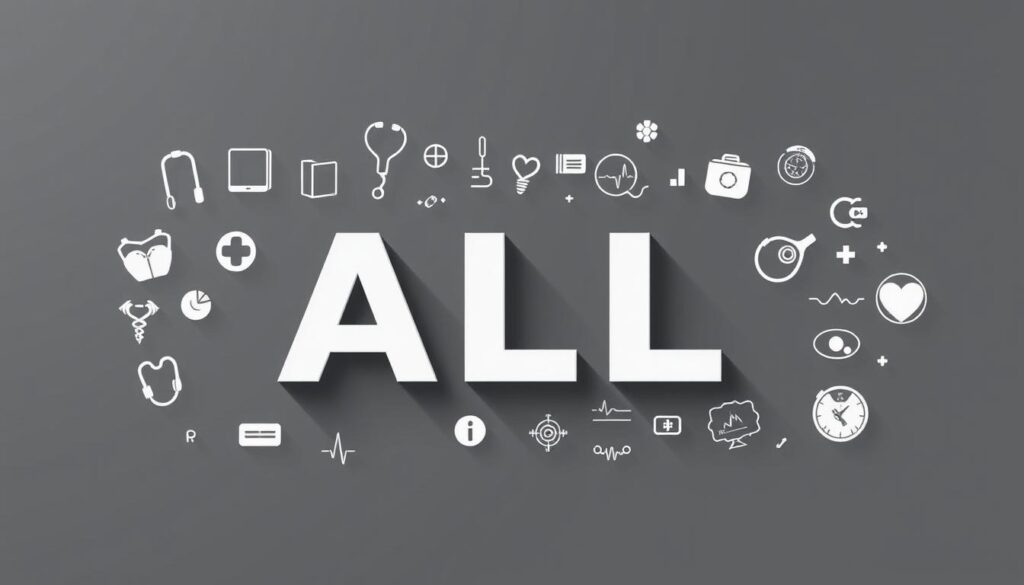Last Updated on October 30, 2025 by Bilal Hasdemir

Knowing medical abbreviations is key for healthcare workers and patients. At Liv Hospital, we stress the need for clear talk in medical notes.
We see how medical shorthand matters in healthcare, such as ALL medical abbreviation, which stands for Acute Lymphoblastic Leukemia. Our goal is to keep up with the latest in medical education and global standards.
In this piece, we dive into 50 key abbreviations and their meanings for easy access. This helps make healthcare talk clear and quick.

In the fast world of healthcare, medical abbreviations are key. They help doctors share complex info fast and right. We use them to talk clearly, avoid mistakes, and care for patients better.
Medical abbreviations are key to patient safety. They let doctors quickly get and act on important information. Our well-trained personnel at Liv Hospital uses clear medical terms for everyone’s safety.
By using the same abbreviations, we avoid mix-ups. This helps keep patients safe from harm.
Good talk is also key to efficient patient care. Medical abbreviations help doctors write and share patient information fast. This means quicker help and treatments for patients.
Research shows 60-70% of doctors use standard medical abbreviations every day. This shows how important it is to stick to these terms. Knowing and using medical abbreviations right helps us. It makes patient care better, improves doctor talk, and keeps care standards high.

Knowing the ALL medical abbreviation is key for doctors to make correct diagnoses and treatments. The ALL abbreviation is vital in diagnosing and treating a certain type of cancer. We will look into its meaning, how it’s used in medicine, and related terms. This will help doctors understand and use this important abbreviation better.
Acute Lymphoblastic Leukemia (ALL) is a blood and bone marrow cancer. It happens when there are too many young white blood cells. If not treated fast, ALL can get worse quickly. The ALL medical abbreviation is often used in hospitals to talk about this disease.
The ALL abbreviation is used in many ways in medicine:
There are other abbreviations for blood and lymphatic conditions, such as:
These abbreviations are very important for making accurate diagnoses and treatment plans in hematology and oncology.
In medical diagnostics, abbreviations are key for quick patient care. They help doctors talk clearly, making sure patients get the right diagnosis and treatment.
Blood tests are very important for diagnosis. Knowing their abbreviations is essential. Common ones include CBC (Complete Blood Count), CMP (Comprehensive Metabolic Panel), and LFT (Liver Function Test). These tests check for things like anemia or liver disease.
A CBC looks at blood parts like red and white cells. It helps find infections or blood problems. A CMP checks how well the body’s metabolism works, like blood sugar and electrolytes.
Imaging studies help find many medical issues. You’ll see MRI (Magnetic Resonance Imaging), CT (Computed Tomography), and US (Ultrasound) often. These tools show what’s going on inside the body.
An MRI is great for soft tissue or brain and spinal cord issues. A CT scan is fast for emergency checks, like injuries or bleeding inside.
Many diagnostic procedures have short names for quick use. For example, ECG (Electrocardiogram) checks the heart, and EEG (Electroencephalogram) looks at brain activity. Knowing these helps doctors understand test results better.
These tests are key for finding heart problems or seizures. Doctors need to know these abbreviations to care for patients well.
Vital signs and patient assessment abbreviations are key in checking patient health and making clinical decisions. These abbreviations help healthcare workers quickly understand a patient’s condition. They guide decisions and ensure effective care.
Cardiovascular monitoring is vital in patient assessment. It uses specific abbreviations to describe heart function and blood pressure. Common ones include:
These abbreviations help healthcare providers quickly understand a patient’s heart and blood pressure status. This makes it easier to act fast when needed.
Respiratory and temperature assessments are also key in patient evaluation. They have their own set of abbreviations. Key examples are:
Knowing these abbreviations is essential for checking a patient’s breathing and temperature. It helps guide the right care and treatment.
By learning these vital signs and patient assessment abbreviations, healthcare professionals can improve their care. They can focus more on the patient’s needs.
In healthcare, using the right treatment and medication abbreviations is key. It helps prevent mistakes and improves patient care. Accurate abbreviations are essential for safe and effective treatment.
Healthcare pros use standard abbreviations for writing prescriptions. Terms like QD (once daily), BID (twice daily), and TID (three times daily) are common. They make it easier to write down medication instructions without confusion.
But, it’s important to remember that these abbreviations can sometimes be misread. For example, QD might look like QID (four times daily) if not written clearly. So, clear handwriting and electronic prescriptions are best.
Medication abbreviations help doctors quickly know what a drug is for. For instance, ACE inhibitors are used to treat high blood pressure and heart failure. Knowing these abbreviations is key to managing medications well.
These abbreviations make communication easier and help doctors remember medication classes quickly. This leads to better patient care.
Some medication abbreviations can be dangerous because they might be misread. The Joint Commission and others warn about abbreviations like U (for units). It can be confused with 0 (zero) or 4, causing dosing mistakes.
To avoid these risks, we suggest not using U and instead write units in full. Also, write out µg (micrograms) instead of using the abbreviation to avoid confusion with mg (milligrams).
Knowing about these risky abbreviations and avoiding them can greatly reduce medication errors. This makes patient care safer.
Using standardized medical abbreviations is key to clear communication in healthcare. These abbreviations help us understand the body and medical conditions. They make it easier for doctors and nurses to talk about patient care.
The heart and blood vessels are vital for life. Important abbreviations include LV for left ventricle, RV for right ventricle, and ECG (or EKG) for heart tests. Knowing these helps doctors diagnose and treat heart problems.
For example, LVH (left ventricular hypertrophy) and CAD (coronary artery disease) are often used. Knowing these terms helps doctors work better together and care for patients better.
The brain, spinal cord, and nerves control our body. Important abbreviations are CNS for the brain and spinal cord, PNS for nerves, and CSF for brain fluid. These are key for brain and nerve care.
Terms like MS (multiple sclerosis) and AD (Alzheimer’s disease) are used a lot. Doctors need to know these to give the best care.
The GI system deals with digestion, and the GU system with reproduction and urine. Important GI terms are GI for the digestive system, GERD for acid reflux, and IBD for bowel disease.
In the GU system, UTI (urinary tract infection) and BPH (benign prostatic hyperplasia) are common. Knowing these helps doctors diagnose and treat better.
The musculoskeletal system includes muscles, bones, and joints. It helps us move and supports our bodies. Important terms are OA for joint disease, RA for arthritis, and ACL for the knee ligament. Knowing these is key to joint and muscle care.
In orthopedic care, terms like FX (fracture) and ORIF (surgery for broken bones) are used a lot. Knowing these helps doctors and nurses work better together.
In summary, medical abbreviations are vital for clear communication in healthcare. By using them correctly, doctors and nurses can improve patient care and work more efficiently.
In emergency and critical care, using specific medical abbreviations is key for quick action. Clear communication among healthcare workers is vital. We use standard abbreviations to avoid delays and ensure patient care is top-notch.
Trauma assessment is a big part of emergency medicine. It needs fast and accurate checks on patients. Terms like GCS (Glasgow Coma Scale) and ISS (Injury Severity Score) help us understand injury severity and decide on treatments.
| Abbreviation | Description |
| GCS | Glasgow Coma Scale |
| ISS | Injury Severity Score |
| RTS | Revised Trauma Score |
During resuscitation and life support, clear talk is essential. Terms like CPR (Cardiopulmonary Resuscitation), ACLS (Advanced Cardiovascular Life Support), and PALS (Pediatric Advanced Life Support) are key for right care.
Triage sorts patients by how urgent they need care. Terms like START (Simple Triage and Rapid Treatment) and ESI (Emergency Severity Index) help sort patients well.
Knowing these abbreviations is key for good triage and emergency response. We need to know them to give the best care in emergencies.
| Abbreviation | Description |
| START | Simple Triage and Rapid Treatment |
| ESI | Emergency Severity Index |
Medical professionals use abbreviations to talk quickly and care for patients well. Different fields have their own terms that are key for clear talk.
Oncology, the study of cancer, has many abbreviations. There’s more than just ALL (Acute Lymphoblastic Leukemia). Other important ones are:
Knowing these abbreviations helps with accurate diagnosis and treatment planning. For example, knowing the difference between ALL and AML is key because they need different treatments.
In obstetrics and gynecology, certain abbreviations are used. They help document patient info and talk clearly. Some common ones are:
These abbreviations are key for tracking pregnancy and planning for delivery. For instance, a patient’s gravida and para status greatly affect their care plan.
Pediatrics and geriatrics have their own abbreviations. In pediatrics, NICU (Neonatal Intensive Care Unit) and PICU (Pediatric Intensive Care Unit) are used. In geriatrics, ADL (Activities of Daily Living) is used to check a patient’s ability to do daily tasks.
Surgical specialties use abbreviations for procedures and patient conditions. Some examples are:
Knowing these abbreviations is key for surgical teams to talk clearly and keep patients safe during and after surgery.
In conclusion, medical abbreviations are very important in healthcare. Learning these abbreviations helps us care for patients better and improve health outcomes in many specialties.
Documentation and administrative medical abbreviations are key to smooth healthcare operations. They help healthcare teams talk clearly and work together well. This section looks at the important abbreviations for managing healthcare.
Medical records and chart notations are vital for keeping patient information. Abbreviations like ‘HPI’ for History of Present Illness and ‘SOAP’ for Subjective, Objective, Assessment, and Plan make it easier. They help speed up the process.
Healthcare places use special abbreviations for easy identification and communication. For example, ‘ICU’ means Intensive Care Unit, and ‘OR’ is the Operating Room. Knowing these helps you get around healthcare settings.
Insurance and billing in healthcare have their own set of abbreviations. ‘ICD’ stands for International Classification of Diseases, and ‘CPT’ is for Current Procedural Terminology. These are key for coding and billing.
Here’s a quick list of some common abbreviations:
| Abbreviation | Meaning | Context |
| HPI | History of Present Illness | Medical Records |
| SOAP | Subjective, Objective, Assessment, and Plan | Chart Notation |
| ICU | Intensive Care Unit | Healthcare Facility |
| CPT | Current Procedural Terminology | Insurance and Billing |
In short, knowing these abbreviations is essential for good healthcare management. It helps teams communicate better, lowers mistakes, and improves care for patients.
Learning medical abbreviations is key for healthcare workers to give top-notch care. At Liv Hospital, we know how important clear talk is in medical notes. Knowing what “ALL” means, like Acute Lymphoblastic Leukemia, helps doctors make the right diagnosis and treatment.
In this article, we looked at many medical abbreviations and what they mean. This shows how vital they are for patient care. By knowing these abbreviations, doctors can talk clearly and avoid mistakes. This knowledge greatly helps patients.By learning medical abbreviations, doctors can improve care and help patients get the best treatment.
A.L.L. stands for Acute Lymphoblastic Leukemia. It’s a cancer that affects the blood and bone marrow.
Medical abbreviations are key to patient safety and better communication. About 60-70% of clinicians use them every day.
Common abbreviations include those for blood tests, imaging, and procedures. They help healthcare professionals talk clearly and quickly.
Knowing medical abbreviations is critical for quality care. It makes sure doctors and nurses can communicate clearly and efficiently.
Knowing medical terms, including abbreviations, is vital. It helps healthcare professionals give top-notch care and support to patients worldwide.
Yes, some medication abbreviations can be risky. Healthcare professionals should avoid them to prevent mistakes and keep patients safe.
Abbreviations differ in specialties like oncology and pediatrics. It’s important for professionals to know the specific terms used in their field.
In emergency and critical care, abbreviations are essential. They help doctors and nurses work fast and effectively in urgent situations.
Professionals can keep up with abbreviations by using reliable sources. This ensures they use the latest and most accurate terms.
Subscribe to our e-newsletter to stay informed about the latest innovations in the world of health and exclusive offers!
WhatsApp us